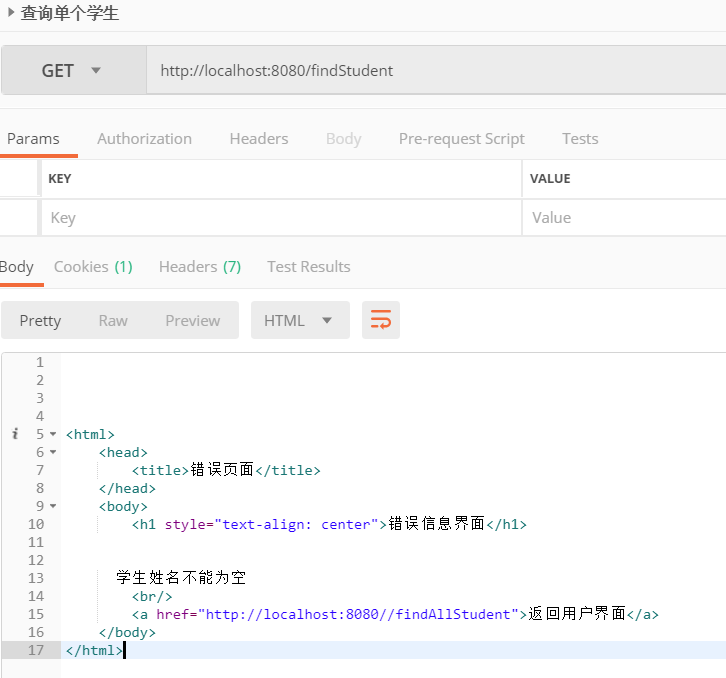发表于: 2018-10-13 23:00:01
1 675
今天完成的事情:
一、完成接口的校验
Springmvc本身没有校验功能,它使用hibernate的校验框架
添加 jar包
<!--接口校验-->
<!-- https://mvnrepository.com/artifact/javax.validation/validation-api -->
<dependency>
<groupId>javax.validation</groupId>
<artifactId>validation-api</artifactId>
<version>1.1.0.Final</version>
</dependency>
<!-- https://mvnrepository.com/artifact/org.hibernate/hibernate-validator -->
<dependency>
<groupId>org.hibernate</groupId>
<artifactId>hibernate-validator</artifactId>
<version>4.3.0.Final</version>
</dependency>
在springmvc.xml中配置validator校验器
<!--配置validator校验器-->
<bean id="validator" class="org.springframework.validation.beanvalidation.LocalValidatorFactoryBean">
<!-- 校验器,使用hibernate校验器 -->
<property name="providerClass" value="org.hibernate.validator.HibernateValidator"/>
<!-- 指定校验使用的资源文件,在文件中配置校验错误信息,如果不指定则默认使用classpath下面的ValidationMessages.properties文件 -->
<property name="validationMessageSource" ref="MessageSource"/>
</bean>
<bean id="MessageSource" class="org.springframework.context.support.ReloadableResourceBundleMessageSource">
<!-- 指定校验信息的资源文件的基本文件名称,不包括后缀,后缀默认是properties -->
<property name="basename" value="Messages"/>
<!-- 指定文件的编码 -->
<property name="fileEncodings" value="utf8"></property>
<!-- 对资源文件内容缓存的时间,单位秒 -->
<property name="cacheSeconds" value="120"></property>
</bean>
将validator注册到适配器中
<mvc:annotation-driven conversion-service="conversionService" validator="validator"/>
在classpath 路径 创建message.properties文件
该配置文件的作用就是存储校验失败时的提示文字信息的,也就是相当于将其提取出来放到配置文件中
student.name.notnull=请输入学生姓名
student.id.notnull=请输入学生的ID
student.school.notnull=请输入学生的毕业院校
在pojo中指定校验规则
public class Student {
/**
@NotEmpty 用在集合类上面
@NotBlank 用在String上面
@NotNull 用在基本类型上
*/
@NotBlank(message = "学生姓名不能为空")
private String name;
private int qq;
private String learn_type;
private long entrance_time;
private String school;
@NotNull(message = "请填写id")
private long id;
private String daily_link;
private String wish;
private String senior;
private String way;
private long create_time;
private long update_time;
controller中对其校验绑定进行使用
/**
* 根据姓名查询学生
*/
@RequestMapping(value="/findStudent",method = RequestMethod.GET)
public String findStudent(Model model, String name, @Validated Student student, BindingResult result){
if (name==null && result.hasErrors()){
List<ObjectError>allErrors=result.getAllErrors();
for (ObjectError objectError:allErrors) {
System.out.println(objectError.getDefaultMessage());
}
model.addAttribute("errors",allErrors);
return "error";
}
List<Student> studentList=studentService.findStudentByName(name);
System.out.println(studentList);
model.addAttribute(studentList);
return "select";
}
1、@Validated作用就是将pojo内的注解数据校验规则(@NotNull等)生效,如果没有该注解的声明,pojo内有注解数据校验规则也不会生效
2、BindingResult对象用来获取校验失败的信息(@NotNull中的message),与@Validated注解必须配对使用,一前一后
3、代码中的逻辑应该很容易看懂,就是将result中所有的错误信息取出来,然后到原先的页面将错误信息进行显示,注意,要使用model对象,则需要在形参中声明Model model,然后菜能使用
jsp页面
<%@taglib prefix="c" uri="http://java.sun.com/jsp/jstl/core" %>
<%@ page language="java" contentType="text/html; charset=UTF-8" pageEncoding="UTF-8"%>
<% String path=request.getContextPath();
String basePath=request.getScheme()+"://"+request.getServerName()+":"+request.getServerPort()+path+"/";%>
<html>
<head>
<title>错误页面</title>
</head>
<body>
<h1 style="text-align: center">错误信息界面</h1>
<c:if test="${errors!=null&& errors.size()>0}" >
<c:forEach items="${errors}" var="error">
${error.defaultMessage}<br/>
</c:forEach>
</c:if>
<a href="<%=basePath%>/findAllStudent">返回用户界面</a>
</body>
</html>
postman测试

明天完成的任务
1、配置域名
2、提交任务,深度思考
遇到的问题
1、无法读取都message.propertie文件





评论